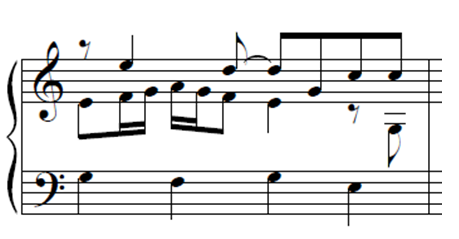
| A | E | B | F♯ | C♯ | G♯ | ||||
| F | C | G | D | A | E | B | F♯ | ||
| (D♭) | (A♭) | (E♭) | B♭ | F | C | G | D | A | E |
| F | C |
The grey row above contains the notes that appear in the annotated score further down on this page. The notes in parentheses are not actually played in this music.
You can download zipped .csv files containing the exact intervals used in this piece. Explanation of column headers.
One example of a harmonic minor third with pitch ratio 32/27 that sounded bad to me in an earlier version, was in measure 16. The middle voice decends from A to G, to the 'chord' F-G-E:

This is how measure 16 sounded in that earlier version, in half speed (and in just intonation):
The harmonic intervals at that point (disregarding octaves and interval directions) were:
| Tones | Interval name | Pitch ratio |
| G F | Whole tone | 10/9 |
| G E | Minor third | 32/27 |
| F E | Minor second | 16/15 |
In the matrix above, these tones are:
| G | E | ||
| F |
The optimizer endorses this, as 32/27 is generally indispensable. In February 2019, I added the possibility to the software to add optimizer hints for minor thirds. When we add such a hint to the E in this chord, the chord gets the following shape in the matrix above:
| E | ||
| F | G |
That makes measure 16 sound as follows, again in half speed:
It has been suggested to me that this piece might sound better in sixth comma meantone tuning. As you can verify in the matrices on this page, Bach used only 11 different note names, contiguous in the spiral of fifths. So, in meantone tuning, the piece could even be played on an ordinary keyboard: it needs G♯ but not A♭, etc.
(sixth comma meantone)
| E | B | F♯ | C♯ | G♯ | ||||
| C | G | D | A | E | B | F♯ | C♯ | |
| B♭ | F | C | G | D | A | E | ||
| B♭ | F | C |
Comparison:
| Measurement | Main version | Experiment 1 |
| Syntonic commas (direct & mid-air) | 0 | 11 |
| Pitches/octave | 23 | 23 |
| Harmonic minor 3rds 6/5 | 155 | 180 |
| Harmonic minor 3rds 32/27 | 38 | 13 |
Some of the syntonic commas are mid air syntonic commas. In the version above, they have been rendered as tone repetitions: the virtual organist releases a key and only then presses another. What if we render the piece with a 2 msec pitch slide for a mid air syntonic comma? Listen:
You can download the score of this piece (pdf) that has been automatically annotated for just intonation, as explained here. The only manual post-editing was adapting the vertical positions of the newly added marks, so they would not get printed through the notes. The marks in the score include note names that refer to those in de grey matrix-row in the top of this page.